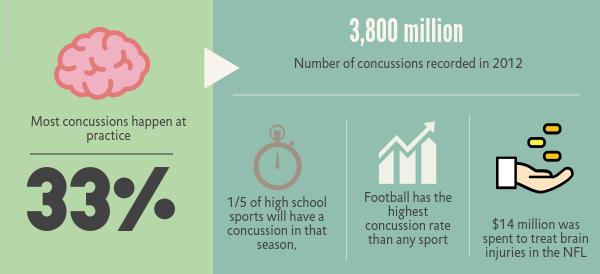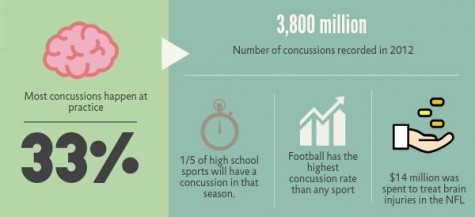No pain no glory for athletes

More athletes are put under the threat of injuries, such as concussions. High school coaches and athletes are taking precautions to avoid such injuries.
December 18, 2015

More athletes are put under the threat of injuries, such as concussions. High school coaches and athletes are taking precautions to avoid such injuries.
Sophomore Dean Khazanov sprained his right ankle on the last pre-season game for football. Luckily for him, this isn’t the worst injury an athlete can get.
“Rey (Flores) played running back and linebacker and he got a concussion in one of the last games of the season,” Khazanov said.
According to brainline.org, football accounts for 60 percent of concussions in high school sports. Football is the leading cause of concussions in male high school athletes, while soccer is the leading cause for females.
Due to the large amount of injuries that varsity football players at Palos Verdes Peninsula High School suffered, officials at the school canceled the remaining three games left of the season. They feared that the health of the football players would be in too much jeopardy if the team continued to play.
“Football isn’t an easy sport to prevent injury. It could happen to any player; you could be away from the ball and still get hurt,” Khazanov said.
Concussions are traumatic brain injuries that change the way the brain works. They can be caused by hits to the head, neck or upper body. These hits can cause the brain to move around inside the skull. The Centers for Disease Control and Prevention (CDC) state that these sudden jolts cause the brain to stretch, which damages cells and chemical changes occur in the brain.
“This last season alone, at least five players have gotten concussions this season, which is actually pretty good considering we’ve got over a 100 guys playing football,” Coach Scott Silva said.
Some of the symptoms of concussions include headaches, confusion, lack of coordination, memory loss, nausea and dizziness. There are also signs that coaches, teammates, or parents should be observed such as looking dizzy or spaced out, forgetting plays, getting confused by plays, slurred speech, and passing out among other things.
“When you get injured, it just kind of happens. There’s nothing you can really do about it,” senior Eric Flowers said.
According to the American Academy of Orthopaedic Surgeons, the two main types of injuries that high school athletes get are acute and overuse injuries. Acute injuries can include bruises, sprains, strains, fractures, and concussions. Overuse injuries are injuries caused by repeating any athletic activity too much and happen gradually over time.
“We had one (concussion) last year, and another this year by the same player,” Flowers said.
“There’s not much you can do that can prevent concussions. It can happen in any sport,” Silva said. “Football is obviously one of the major ones because of players tackling and using equipment like helmets that can cause those things.”
There has been research done on helmets worn by football players that have come to the conclusion that helmets aren’t great at preventing concussions. As stated in sportsafetyinternational.org, helmets are effective in reducing the number of skull fractures and brain contusions.
If a player gets a concussion, a protocol is followed given by the California Interscholastic Federation (CIF).
“Concussions have no boundaries,” Silva said. “They have no bias in who they can affect in what sport.”









